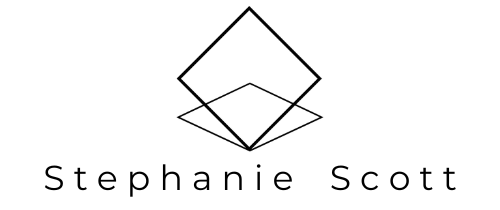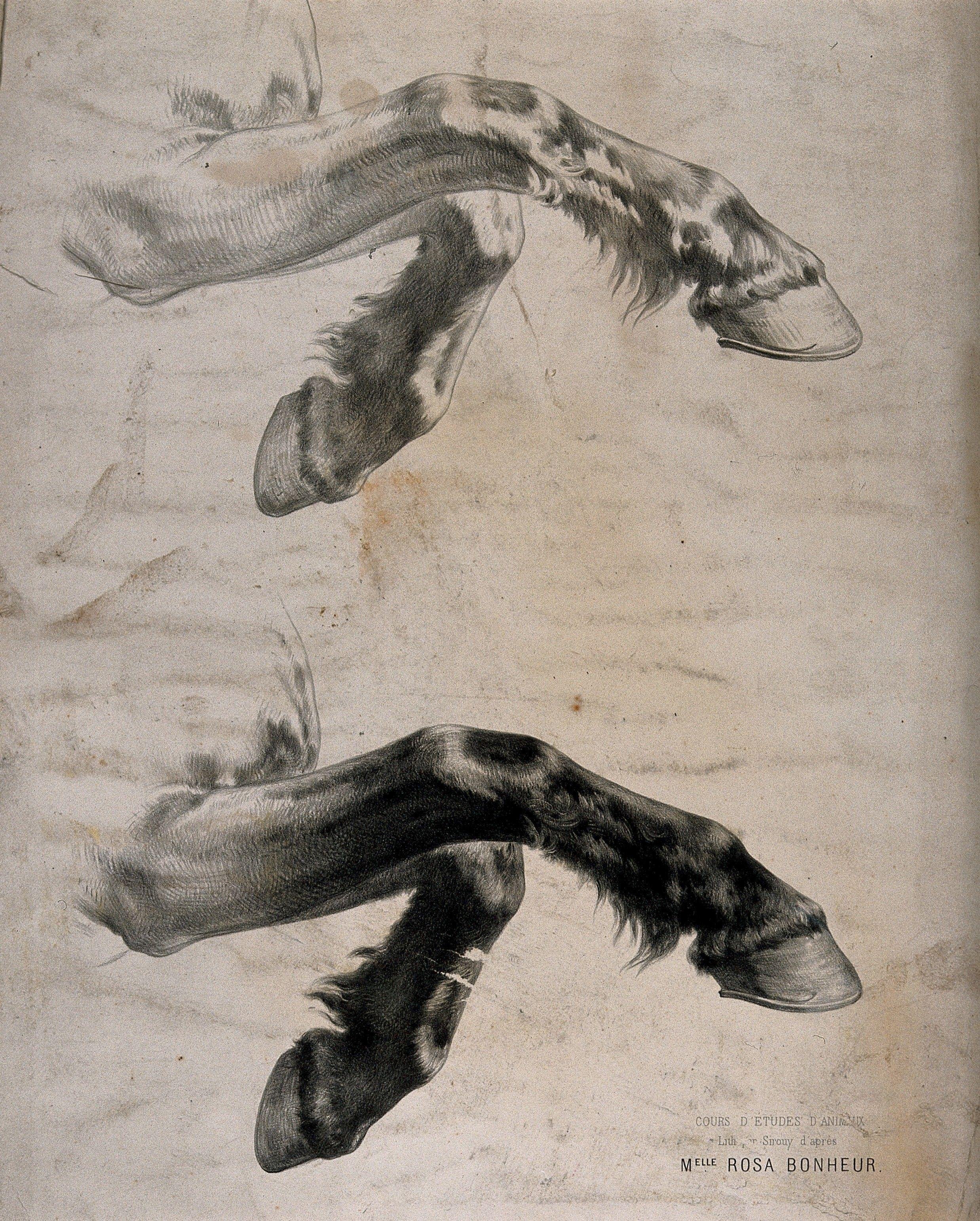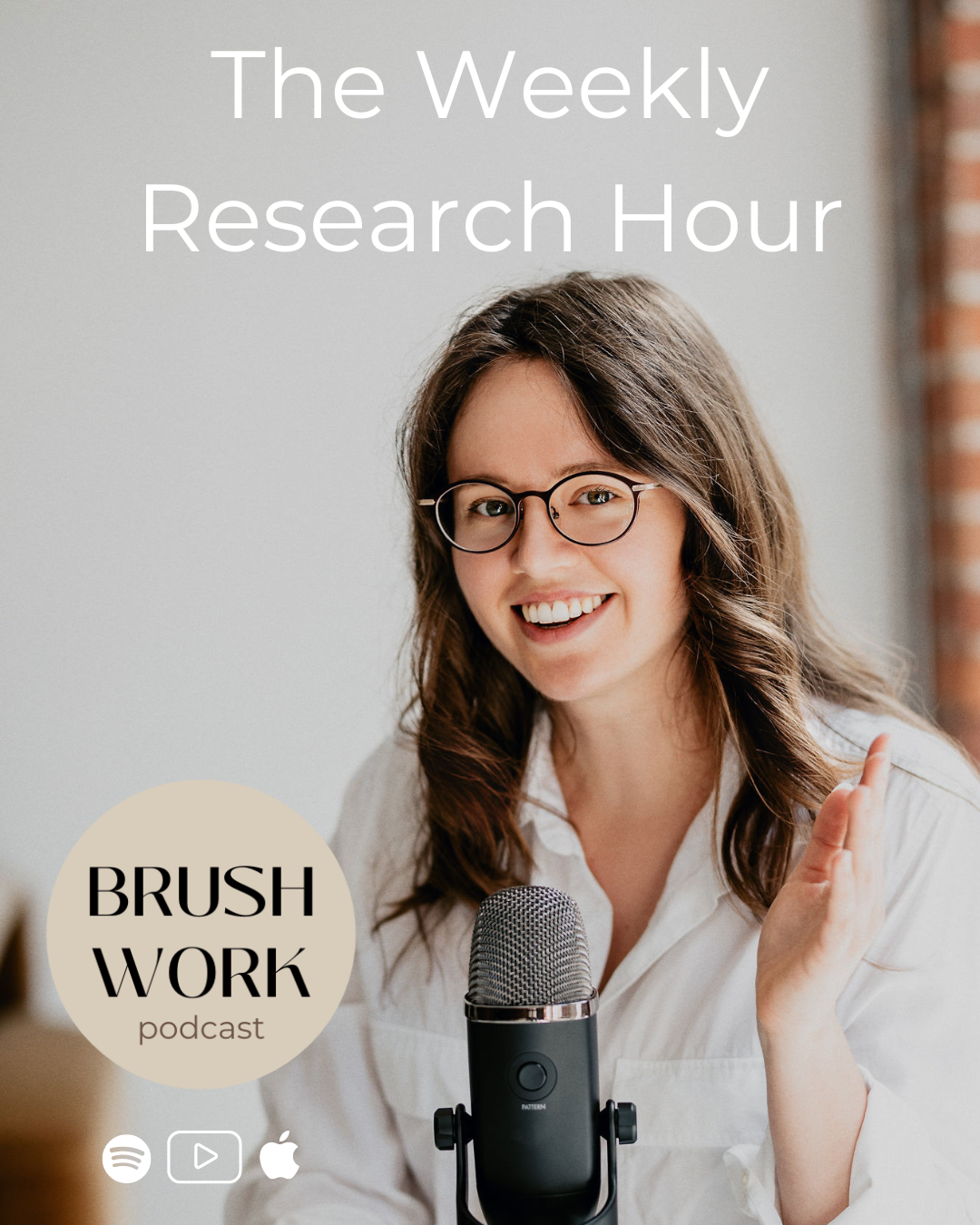The Weekly Research Hour
Why artists need a weekly research hour:
Spending one hour a week dedicated to research has changed my life. Before I had a research hour I was creatively stagnate and my artwork repetitive. Now, every time Tuesday morning rolls around I get excited to explore something new. I’m feeding my mind and expanding the capabilities of my inner artist. My paintings are evolving and ideas are coming faster than I can keep up with.
Do you want this too? Keep reading!
Last fall I finished The Artist’s Way and installed a habit called The Artist Date. Essentially it’s a time once a week where you do something to feed your inner artist. One time during the program I went to the library and gorged myself on beautiful art books. It created a thirst for knowledge that I now schedule into my week.
Researching with your Artist Hat on is delicious and addicting. It influences what I’m painting, what I make for Brush Work, my conversations at dinner, and how I’m observing the world. Here’s how to do a successful research hour and where I like to spend mine.
Tips for successful researching:
Set a timer- Treating this research hour like an appointment is my favorite way to stay on track. I set a timer for 60 min, then let myself go where the ideas take me. Having a hard cut off keeps me from diving too deep and getting distracted.
Have something scheduled for after. If you are the kind of person that can get lost in the research (It’s me, hi) then planning something for after the hour is up is a great tactic. It creates a pressure on the hour that keeps me focused.
Have a notebook/journal just for research- Using a notebook of some sort, heck even your sketchbook will help cement your observations and ideas that generate during your research hour. Hand writing things is great for memorization.
Use a digital note app- If a digital file would work better for you, then use that!! I do appreciate something that is searchable.
Pick an intention- Before you head out to the library, a museum, or the university of YouTube; pick a focus for your study. Having something that you want to research before throwing yourself at a multitude of resources will be the appetizer to the research meal.
Set the next research hours focus at the end of your current one. At the end of your hour, if you have more things you want to look up, write them down! You can use that note to set the tone for the next week’s research hour.
Chase the Rabbit- If you are researching something and a new idea pops up, chase it! You don’t have to stick to your intended research subject. Chasing the Rabbit can lead to the brightest breakthroughs and rewarding ah-ha’s!
Do your Research Hour the same time every week. Mine is on Tuesday mornings. I get my tea and then get to studying. I really look forward to the time to expand my mind and seek out new things.
Where to research:
YE OL LIBRARY- Look, I live in Seattle and am spoiled for quality libraries. I can get almost any book from my library for free, anytime I want. It’s magic. This might not be an option for where you live, but I dare you to try it and see for yourself.
In person: There is something keen about physically going somewhere to do research. It changes how you dress, how you think, how you plan for the day. I think there is power in the physicality of it. Visiting the library, pulling out your card, and touching the books is nearly romantic.
Thinking about your chosen topic, pull 3-5 books from the stacks (ask your librarian for help) and get a table. Set your timer when you’ve sat down and then peruse. Copy down quotes you find, note strong opinions that rise up when reading, take notes on what is intriguing.
The best part of reading books is not reading the ENTIRE book. Skim through the pages, just look at the pictures, discard what isn’t ‘speaking’ to you.
On Libby: Once every few weeks I add a bunch of books to my holds list on the Libby app. Then as holds are ready I’ll save them for my research hour and spend some time reading. Libby has dramatically increased how much I read every year- like double!!
YouTube- Sometimes I hear from people “I’ve learned more from YouTube than I ever did at school”. YouTube is a wealth of information, if you know how to look. It’s very easy to let the algorithm lead you astray, so you have to keep it focused. Here’s how I spend a YouTube research hour:
The first 10 min: Focusing on my chosen topic, I mine for videos to watch. Just judging on titles alone, I’ll add them to my ‘watch later’ playlist and then look for the next video. You are basically making a stockpile of videos to watch.
The rest of your time: Pull out your notebook and be an active listener/watcher. Don’t stray from your ‘watch list’. If you see a recommended video, add it to the watch list but don’t immediately click on it. If the video doesn’t teach you enough, skip to the next.
Make an account just for researching- I have a separate email and YouTube account just for my researching. It keeps the ‘Entertaining’ videos off my main feed after just a few videos watched and will start showing me videos related to art, history, business, and theory. Keeping disciplined and separating the videos you watch will keep the accounts clean and focused.
Museums- I absolutely consider going to museums as research. Sometimes I allow myself longer than an hour for these jaunts. Going with a friend can be fun, but I recommend research trips to be solo.
Bring your sketchbook and draw. Yes you can get quality images online but you’ll train your eye better if you draw from life.
Pick a specific area of the museum to study. This will keep your research focused and away from trying to ‘see it all’. Even if your museum is small, niche down.
Ask questions Usually the people work at the museum are very knowledgeable about the exhibit. See if they can tell you about the work beyond what is written in the blurbs on the wall.
Go online- Can’t physically get to the museum you want to go to? Visit them online. Often they will have incredibly detailed logs of every piece of art ever shown. Sometimes they have virtual tours, sometimes audio guides, all for free.
Rosa Bonheur. Study of a Horse’s Front Legs in Motion: Two Figures. Lithograph by Sirouy after R. Bonheur, 1859. 1859. Wellcome Collection, JSTOR, . Accessed 8 Apr. 2024.
Google Arts & Culture - What a brilliant resource to play in! Google has done all the hard work for you and searched high quality images and referenced their sources. I love studying drawings and using the color explorer tool they have.
The Getty Research Portal - Get your historical books here! A place where digitized historical books live. Easy for researching particular artists, viewing curated collections, and getting images for studying.
JSTOR - Free access to artwork, journals, documents, books, serials, and so much more. JSTOR saves lives. I love spending an hour diving into this site and researching. Highly recommend picking an artist and seeing everything that pops up about them as your first foray into this platform.
You’ll need to make a personal account in order to access JSTOR’s resources, or sign up though a library. Both are very easy to do. The image on the left was accessed through JSTOR.
The Khan Academy - Want to learn something? ANYTHING? This academy is rich in resources even beyond art. I especially love it for Art History. Great if you want easy to follow articles with a few videos sprinkled in.
The Metropolitan Museum of Art: Heilbrunn Timeline of Art History - Ever want to see all of art history lined up in one timeline? This is the resource for you. It’s so much fun and a little wild to see how art history has evolved at such break neck pace.
There are so many more places to research, classes to take, and articles to read than I could list here. I hope overall I’ve inspired you to take some time once a week to feed your mind and expand on your creativity outside of drawing or painting. Take care!
Host and artist Stephanie Scott breaks down the practicality of the art career with topics including: sustainable creative practices, social media skills, and the mindsets to keep us in the studio. New episodes every Tuesday!
Instagram: https://www.instagram.com/stephaniescott.art/
Website: http://www.stephaniescott.art/brushwork
Music by @winepot https://www.instagram.com/thewinepot/
Submit to Brush Work: https://www.stephaniescott.art/brush-work-submission
YouTube: https://www.youtube.com/@stephaniescottart
Podcast Cover photo by Maryna Blumqvist https://instagram.com/picturemaryna



